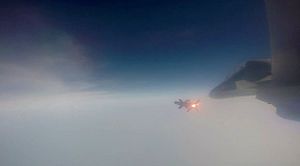India’s first domestically designed and developed beyond visual range air-to-air missile (BVRAAM), designated Astra, is ready for induction into the Indian Air Force’s (IAFs) inventory following the successful completion of pre-induction trials, the Indian Ministry of Defense (MoD) said on October 4.
The Astra BVRAAM is slated for induction in 2019.
The tests were conducted between September 26 and October 3 at Integrated Test Range (ITR), Balasore as part of the final development trials of the missile. The pre-induction trials entailed the firing of the missile from an IAF Sukhoi Su-30MKI multirole air superiority fighter against unmanned aerial vehicles. According to information supplied by the MoD, the missile hit and destroyed all of its designated aerial targets.
“Astria has been tested six times under different launch conditions and ranges as part of the final development trial. The missile has engaged targets and all the mission objectives have been met,” the MoD said on October 4. The Astra has been under development by India’s Defense Research and Development Organization (DRDO) for the past decade. The weapon system has undergone over twenty development trials.
Limited serial production of the Astra BVRAAM kicked off in 2017.
Last month, I laid out the technical details of the new missile system:
With a speed of Mach 4.5, the missile’s maximum range when fired from an altitude of 15,000 meters is about 110 kilometers, which is reduced to about 44 kilometers when launched at an altitude of 8,000 meters. Fitted with a high-explosive pre-fragmented warhead, the missile uses an inertial guidance system with an active radar seeker with a homing range of 25 kilometers.
The Astra BVRAAM will be integrated with the IAF fleet of Su-30MKI, the backbone of India’s fighter force. (The IAF currently operates 272 Su-30MKIs. India is in talks with Russia over an additional 40 Su-30MKIs for the IAF.) As I reported elsewhere:
The twin-seater, twin-engine Su-30MKI, developed by Russian aircraft maker Sukhoi and license-built in India, constitutes the backbone of the IAF. While the first 50 Su-30 aircraft were built in Russia, the remaining fighter jets were assembled in India. The IAF originally received the older Su-30MK variant from Russia, which the Indian defense industry in partnership with Russian defense companies upgraded to the MKI standard.
Unlike the Russian Su-30SM, the MKI version includes Israeli and French avionics. For example, the aircraft is fitted with a French-made heads-up display system, and an Israeli electronic warfare system and an advanced targeting pod. The Su-30MKI also features AL-37FP thrust-vectoring engines and canard foreplanes for increased maneuverability. HAL and Sukhoi are currently negotiating a contract for the upgrade of older Su-30MKI models in service with the IAF.
DRDO is also currently working on an extended-range variant of the Astra.

































